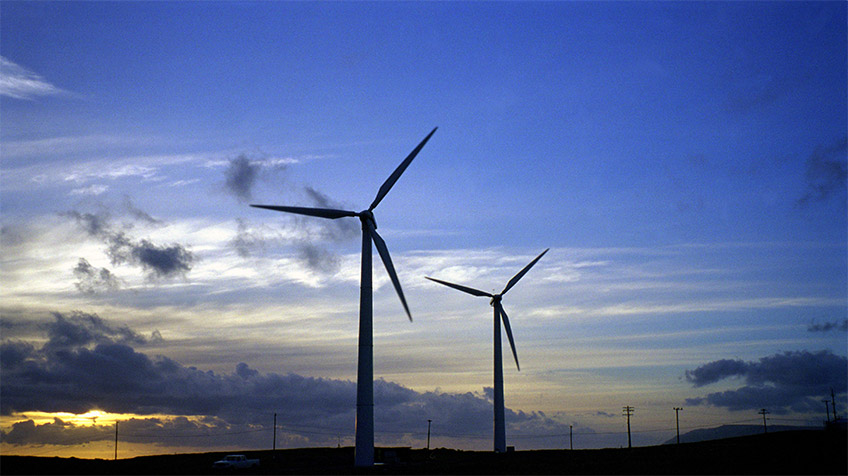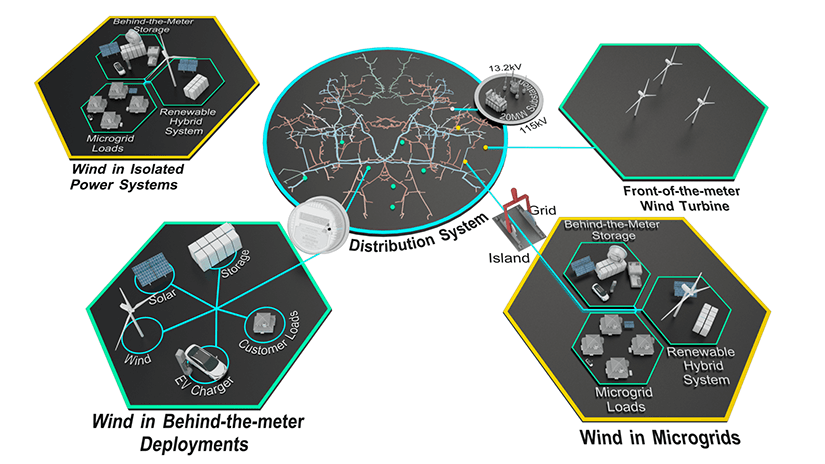MIRACL: Microgrids, Infrastructure Resilience, and Advanced Controls Launchpad
The Microgrids, Infrastructure Resilience, and Advanced Controls Launchpad (MIRACL) was a collaborative, multiyear research effort to accelerate distributed wind energy technology development.

Distributed wind energy experiences many of the same deployment and operational challenges as wind energy deployed at the bulk-transmission scale. Controls, communication, and hardware for grid and microgrid integration of wind energy technology with other distributed energy resources are not well developed or standardized. To address the concerns of the industry, and support development of useful case studies, the MIRACL effort aimed to:
- Improve and validate capabilities of wind technology, at all scales, to integrate in a seamless "plug and play" manner with other technologies into microgrids through coordinated and secure controls and communications protocols
- Conduct research, testing, and standards development to ensure that distributed wind technology can play an active role in high-renewable-contribution, distributed energy-driven grids of the future.
The U.S. Department of Energy’s (DOE’s) Wind Energy Technologies Office and NREL initiated MIRACL in 2018 in response to a request from the distributed wind industry to improve the operation, integration, and valuation of distributed wind energy in transactive environments, microgrids, and distribution system networks. NREL led the collaborative MIRACL team that also includes Idaho National Laboratory, Pacific Northwest National Laboratory, and Sandia National Laboratories.
Project Results
Explore the MIRACL final report to learn more about the project's research areas, activities, and results.
Primary Research Areas
The MIRACL project focused on three research areas, which are discussed in more detail in the final report. They were:
- Valuation and Modeling
Pacific Northwest National Laboratory led efforts to improve valuation of grid system contributions from wind as a distributed energy resource and accurately represent distributed wind energy in models. - Advanced Controls
NREL and Sandia National Laboratories collaborated on advanced controls for hybrid distributed energy resource systems. - Enhanced Resilience
Idaho National Laboratory led efforts to achieve greater, measurable resilience in microgrids and distribution systems through distributed wind energy integration and cybersecurity.
Use Cases
MIRACL use cases spanned a variety of distributed wind energy projects and formed the basis of MIRACL discussions and targeted work packages. Distributed wind energy projects were categorized into use cases with similar technical (interconnection, certification, integration with other renewable energy systems), financial (cost structure, valuation), market (developer, owner), and resilience (energy security, cybersecurity, fuel diversity, financial security) requirements, challenges, and benefits.
The high-level use cases defined for distributed wind energy encompassed wind turbines in:
- Isolated grids
- Grid-connected microgrids
- Behind-the-meter deployments
- Front-of-the-meter deployments.

Find more MIRACL use cases.
Advisory Board
One of the critical concerns of the MIRACL team is that the work completed by the laboratories is relevant to the distributed energy resource industry, with a clear focus on expanding the incorporation of wind power into the distributed energy resource sector. To facilitate this effort, an industry advisory board was regularly consulted on MIRACL research plans and products. The advisory board comprised approximately 10 experts representing organizations such as wind turbine manufacturers, inverter manufacturers, distributed energy resource implementors, distributed energy resource technology developers, storage manufacturers, universities, state governments, nongovernmental organizations, and electric utilities.
Wind in Hybrid Energy Systems
To fully participate in a microgrid, isolated grid, or distribution grid, distributed wind must be able to simply and effectively coordinate with other distributed energy resources on the system. Under this research area, the team worked to identify the challenges and opportunities of wind-centric hybrid systems to add value and support easier integration of distributed wind turbines with solar photovoltaic and energy storage systems. Some of the high-level challenges and opportunities identified included:
- Wind coupled (through alternating current or direct current) with energy storage can
buffer the variability in load and wind generation.
- The cost-benefit trade-offs of coupling wind and storage behind a common inverter
will be investigated between this hybrids research area and the valuation effort.
- Wind coupled with energy storage can overcome the problem of needing to operate a
diesel above a minimum loading by providing load when needed and then providing power
so the diesel can go off.
- Integration of storage and other distributed energy resources in or with the distributed wind turbine and researching the value and effectiveness of integrated dispatchable subsystems that allow a redefinition of the grid using high-variable renewable, distributed power.
Under parallel Hybrid Energy Systems Research, the benefits and opportunities for collocated wind and solar photovoltaic deployments are being investigated and quantified at a national scale. The MIRACL team plans to further evaluate the relationship between wind and solar and identify areas of improvement for grid integration and control between these two complementary technologies. Through partnerships with other MIRACL team members, the value and opportunities for distributed wind and solar deployments will be better quantified and the advanced controls required to effectively connect and operate these deployments will be demonstrated.
Publications
Distributed Wind Considerations from the IEEE 1547-2018 Revision, NREL Technical Report (2021)
Distributed Wind Controls: A Research Roadmap for Microgrids, Infrastructure Resilience, and Advanced Controls Launchpad (MIRACL), NREL Technical Report (2021)
Integration of Storage in the DC Link of a Full Converter-Based Distributed Wind Turbine: Preprint, IEEE Power and Energy Society General Meeting (2021)
Microgrids, Infrastructure Resilience, and Advanced Controls Launchpad (MIRACL) Research: Controls, DOE Fact Sheet (2021)
Microgrids, Infrastructure Resilience, and Advanced Controls Launchpad (MIRACL): Use Cases and Definitions, NREL Technical Report (2021)
Microgrids, Infrastructure Resilience, and Advanced Controls Launchpad, DOE Fact Sheet (2020)
Find a more comprehensive list of publications broken down by research area in the final report.
Contact
Share
Last Updated Feb. 20, 2025
